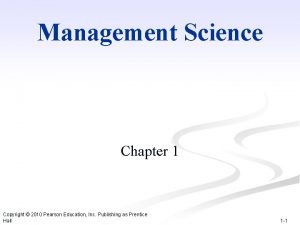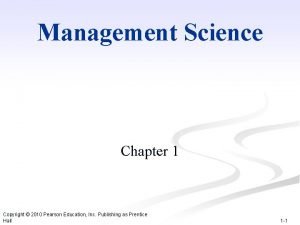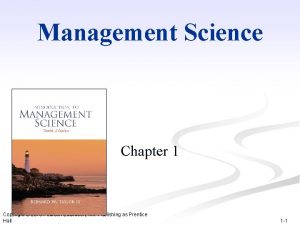Management Science Chapter 1 Copyright 2010 Pearson Education















- Slides: 15

Management Science Chapter 1 Copyright © 2010 Pearson Education, Inc. Publishing as Prentice Hall 1 -1

Chapter Topics n The Management Science Approach to Problem Solving n Model Building: Break-Even Analysis n Computer Solution n Management Science Modeling Techniques n Business Usage of Management Science Techniques n Management Science Models in Decision Support Systems Copyright © 2010 Pearson Education, Inc. Publishing as Prentice Hall 1 -2

The Management Science Approach n Management science uses a scientific approach to solving management problems. n It is used in a variety of organizations to solve many different types of problems. n It encompasses a logical mathematical approach to problem solving. n Management science, also known as operations research, quantitative methods, etc. , involves a philosophy of problem solving in a logical manner. Copyright © 2010 Pearson Education, Inc. Publishing as Prentice Hall 1 -3

The Management Science Process Figure 1. 1 Copyright © 2010 Pearson Education, Inc. Publishing as Prentice Hall 1 -4

Steps in the Management Science Process § Observation - Identification of a problem that exists (or may occur soon) in a system or organization. § Definition of the Problem - problem must be clearly and consistently defined, showing its boundaries and interactions with the objectives of the organization. § Model Construction - Development of the functional mathematical relationships that describe the decision variables, objective function and constraints of the problem. § Model Solution - Models solved using management science techniques. § Model Implementation - Actual use of the model or its solution. Copyright © 2010 Pearson Education, Inc. Publishing as Prentice Hall 1 -5

Example of Model Construction (1 of 3) Information and Data: § Business firm makes and sells a steel product § Product costs $5 to produce § Product sells for $20 § Product requires 4 pounds of steel to make § Firm has 100 pounds of steel Business Problem: § Determine the number of units to produce to make the most profit, given the limited amount of steel available. Copyright © 2010 Pearson Education, Inc. Publishing as Prentice Hall 1 -6

Example of Model Construction (2 of 3) Variables: X = # units to produce (decision variable) Z = total profit (in $) Model: Z = $20 X - $5 X (objective function) 4 X = 100 lb of steel (resource constraint) Parameters: values) $20, $5, 4 lbs, 100 lbs (known Formal Specification of Model: maximize Z = $20 X - $5 X subject to 4 X = 100 Copyright © 2010 Pearson Education, Inc. Publishing as Prentice Hall 1 -7

Example of Model Construction (3 of 3) Model Solution: Solve the constraint equation: 4 x = 100 (4 x)/4 = (100)/4 x = 25 units Substitute this value into the profit function: Z = $20 x - $5 x = (20)(25) – (5)(25) = $375 (Produce 25 units, to yield a profit of $375) Copyright © 2010 Pearson Education, Inc. Publishing as Prentice Hall 1 -8

Model Building: Break-Even Analysis (1 of 9) ■ Used to determine the number of units of a product to sell or produce that will equate total revenue with total cost. ■ The volume at which total revenue equals total cost is called the break-even point. ■ Profit at break-even point is zero. Copyright © 2010 Pearson Education, Inc. Publishing as Prentice Hall 1 -9

Classification of Management Science Techniques Figure 1. 6 Modeling Techniques Copyright © 2010 Pearson Education, Inc. Publishing as Prentice Hall 1 -10

Characteristics of Modeling Techniques n n Linear Mathematical Programming - clear objective; restrictions on resources and requirements; parameters known with certainty. (Chap 2 -6, 9) Probabilistic Techniques - results contain uncertainty. (Chap 11 -13) Network Techniques - model often formulated as diagram; deterministic or probabilistic. (Chap 7 -8) Other Techniques - variety of deterministic and probabilistic methods for specific types of problems including forecasting, inventory, simulation, multicriteria, etc. (Chap 10, 14 -16) Copyright © 2010 Pearson Education, Inc. Publishing as Prentice Hall 1 -11

Business Use of Management Science n Some application areas: - Project Planning - Capital Budgeting - Inventory Analysis - Production Planning - Scheduling n Interfaces - Applications journal published by Institute for Operations Research and Management Sciences (INFORMS) Copyright © 2010 Pearson Education, Inc. Publishing as Prentice Hall 1 -12

Decision Support Systems (DSS) A decision support system is a computer-based system that helps decision makers address complex problems that cut across different parts of an organization and operations. Features of Decision Support Systems n Interactive n Use databases & management science models n Address “what if” questions n Perform sensitivity analysis Examples include: ERP – Enterprise Resource Planning OLAP – Online Analytical Processing Copyright © 2010 Pearson Education, Inc. Publishing as Prentice Hall 1 -13

Management Science Models Decision Support Systems (2 of 2) Figure 1. 7 A Decision Support System Copyright © 2010 Pearson Education, Inc. Publishing as Prentice Hall 1 -14

Copyright © 2010 Pearson Education, Inc. Publishing as Prentice Hall 1 -15
 Copyright 2010 pearson education inc
Copyright 2010 pearson education inc Copyright 2010 pearson education inc
Copyright 2010 pearson education inc Copyright 2010 pearson education inc
Copyright 2010 pearson education inc Copyright 2010 pearson education inc
Copyright 2010 pearson education inc Copyright 2010 pearson education inc
Copyright 2010 pearson education inc Copyright 2010 pearson education inc
Copyright 2010 pearson education inc Copyright 2010 pearson education inc
Copyright 2010 pearson education inc Copyright 2010 pearson education inc
Copyright 2010 pearson education inc Copyright 2010 pearson education inc
Copyright 2010 pearson education inc Copyright 2010 pearson education inc
Copyright 2010 pearson education inc Copyright pearson education inc
Copyright pearson education inc 2017 pearson education inc
2017 pearson education inc 2009 pearson education inc
2009 pearson education inc Copyright pearson education inc
Copyright pearson education inc 2014 pearson education inc
2014 pearson education inc Copyright by pearson education inc. answers
Copyright by pearson education inc. answers





























